Temporal and Spatial Changes of Non-Point Source N and P and Its Decoupling from Agricultural Development in Water Source Area of Middle Route of the South-to-North Water Diversion Project
Abstract
1. Introduction
2. Study Area
2.1. Brief Introduction to the Middle Route of the SNWDP
2.2. Study Area
3. Materials and Methods
3.1. Data Source
3.2. Estimation of NPS Pollutants Amounts
3.2.1. Export Coefficient Model
3.2.2. RUSLE Model
3.3. Decoupling Analysis
4. Results
4.1. DN and DP Estimation
4.1.1. Temporal Variations in DN and DP
4.1.2. Spatial Variations in DN and DP
4.2. AN and AP Estimation
4.2.1. Temporal Variations in AN and AP
4.2.2. Spatial Variations in AN and AP
4.3. Decoupling NPS Pollution from PIOV
5. Discussion
5.1. Uncertainty of the Estimation Results
5.2. Measures for Prevention
5.2.1. Composition Analysis of NPS Pollution
5.2.2. Measures for NPS Pollution Control
- Measure 1 (M1): Reducing the number of livestock.
- Measure 2 (M2): Reducing the rural population.
- Measure 3 (M3): Improving the capacity of waste treatment.
- Measure 4 (M4): Conversion of cropland to forest.
5.3. Comparison with Previous Studies
5.3.1. Previous Studies in Other Regions
5.3.2. Previous Studies in the Same Area
6. Conclusions
Author Contributions
Funding
Acknowledgments
Conflicts of Interest
Abbreviations
| NPS | Non-point Source |
| NPS-N | Non-point Source Nitrogen |
| NPS-P | Non-point Source Phosphoru |
| DN/DP | Dissolved Nitrogen/Phosphorus |
| AN/AP | Adsorbed Nitrogen/Phosphorus |
| ECM | Export Coefficient Model |
| RUSLE | Revised Universal Soil Loss Equation |
| WSA | Water Source Area |
| SNWDP | South-to-North Water Diversion Project |
| PIOV | Primary Industrial Output Value |
| DI | Decoupling Index |
| SD | Strong Decoupling |
| WD | Weak Decoupling |
| RC | Recessive coupling |
References
- Aldieri, L.; Vinci, C.P. The Role of Technology Spillovers in the Process of Water Pollution Abatement for Large International Firms. Sustainability 2017, 9, 868. [Google Scholar] [CrossRef]
- Muyibi, S.A.; Ambali, A.R.; Eissa, G.S. The Impact of Economic Development on Water Pollution: Trends and Policy Actions in Malaysia. Water Resour. Manag. 2008, 22, 485–508. [Google Scholar] [CrossRef]
- Somura, H.; Takeda, I.; Arnold, J.G.; Mori, Y.; Jeong, J.; Kannan, N. Impact of suspended sediment and nutrient loading from land uses against water quality in the Hii River basin, Japan. J. Hydrol. 2012, 450, 25–35. [Google Scholar] [CrossRef]
- Short, J.S.; Ribaudo, M.; Horan, R.D.; Blandford, D. Reforming Agricultural Nonpoint Pollution Policy in an Increasingly Budget-Constrained Environment. Environ. Sci. Technol. 2012, 46, 1316–1325. [Google Scholar] [CrossRef] [PubMed]
- EPA. 319 Grant Program for States and Territories. Available online: https://www.epa.gov/nps/319-grant-program-states-and-territories (accessed on 25 December 2018).
- Liang, L.; Nagumo, T.; Hatano, R. Nitrogen flow in the rural ecosystem of Mikasa City in Hokkaido, Japan. Pedosphere 2006, 16, 264–272. [Google Scholar] [CrossRef]
- Ministry of Environmental Protection of the People’s Republic of China; National Bureau of Statistics; Ministry of Agriculture of the People’s Republic of China. Bulletin of the First National Census of Pollution Sources; National Bureau of Statistics: Beijing, China, 2012. (In Chinese)
- Ye, H.M.; Yuan, X.Y.; Han, L.; Marip, J.B.; Qin, J. Risk Assessment of Nitrogen and Phosphorus Loss in a Hilly-Plain Watershed Based on the Different Hydrological Period: A Case Study in Tiaoxi Watershed. Sustainability 2017, 9, 1493. [Google Scholar] [CrossRef]
- Shen, Z.Y.; Chen, L.; Hong, Q.; Qiu, J.L.; Xie, H.; Liu, R.M. Assessment of nitrogen and phosphorus loads and causal factors from different land use and soil types in the Three Gorges Reservoir Area. Sci. Total Environ. 2013, 454, 383–392. [Google Scholar] [CrossRef]
- Dai, H.J.; Tao, S.; Zhang, K.; Guo, W. Research on Rural Nonpoint Source Pollution in the Process of Urban-Rural Integration in the Economically-Developed Area in China Based on the Improved STIRPAT Model. Sustainability 2015, 7, 782–793. [Google Scholar] [CrossRef]
- Bell, R.G.; Russell, C. Environmental policy for developing countries. Issues Sci. Technol. 2002, 18, 63–70. [Google Scholar]
- Chen, X.K.; Liu, X.B.; Peng, W.Q.; Dong, F.; Huang, Z.H.; Wang, R.N. Non-Point Source Nitrogen and Phosphorus Assessment and Management Plan with an Improved Method in Data-Poor Regions. Water 2018, 10, 17. [Google Scholar] [CrossRef]
- Bouraoui, F.; Dillaha, T.A. ANSWERS-2000: non-point-source nutrient planning model. J. Environ. Eng.—ASCE 2000, 126, 1045–1055. [Google Scholar] [CrossRef]
- Donigian, A.S., Jr.; Bicknell, B.R.; Imhoff, J.C.; Singh, V.P. Hydrological Simulation Program—Fortran (HSPF); EPA: Washington, DC, USA, 1995.
- Santhi, C.; Arnold, J.G.; Williams, J.R.; Dugas, W.A.; Srinivasan, R.; Hauck, L.M. Validation of the SWAT Model on a Large Rwer Basin with Point And Nonpoint Sources. JAWRA 2010, 37, 1169–1188. [Google Scholar] [CrossRef]
- Singh, J.; Knapp Vernon, H.; Demissie, M. Hydrologic modeling of the Iroquios River watershed using HSPF and SWAT. JAWRA 2005, 41, 343–360. [Google Scholar]
- Shen, Z.Y.; Liao, Q.; Hong, Q.; Gong, Y.W. An overview of research on agricultural non-point source pollution modelling in China. Sep. Purif. Technol. 2012, 84, 104–111. [Google Scholar] [CrossRef]
- Shen, Z.Y.; Chen, L.; Ding, X.W.; Hong, Q.; Liu, R.M. Long-term variation (1960–2003) and causal factors of non-point-source nitrogen and phosphorus in the upper reach of the Yangtze River. J. Hazard. Mater. 2013, 252, 45–56. [Google Scholar] [CrossRef] [PubMed]
- Ierodiaconou, D.; Laurenson, L.; Leblanc, M.; Stagnitti, F.; Duff, G.; Salzman, S. The consequences of land use change on nutrient exports: a regional scale assessment in south-west Victoria, Australia. J. Environ. Manag. 2005, 74, 305–316. [Google Scholar] [CrossRef] [PubMed]
- Omernik, J.M. The Influence of Land Use on Stream Nutrient Levels; EPA: Washington, DC, USA, 1976.
- Johnes, P.J. Evaluation and management of the impact of land use change on the nitrogen and phosphorus load delivered to surface waters: the export coefficient modelling approach. J. Hydrol. 1996, 183, 323–349. [Google Scholar] [CrossRef]
- Delkash, M.; Al-Faraj, F.A.M.; Scholz, M. Comparing the Export Coefficient Approach with the Soil and Water Assessment Tool to Predict Phosphorous Pollution: The Kan Watershed Case Study. Water Air Soil Pollut. 2014, 225, 1–17. [Google Scholar] [CrossRef]
- Ding, X.W.; Shen, Z.Y.; Liu, R.M. Temporal-Spatial Changes of Non-point Source Nitrogen in Upper Reach of Yangtze River Basin. J. Agro-Environ. Sci. 2007, 26, 836–841. (In Chinese) [Google Scholar]
- Shrestha, S.; Kazama, F.; Newham, L.T.H.; Babel, M.S.; Clemente, R.S.; Ishidaira, H. Catchment scale modelling of point source and non-point source pollution loads using pollutant export coefficients determined from long-term in-stream monitoring data. J. Hydro-Environ. Res. 2009, 2, 134–147. [Google Scholar] [CrossRef]
- Jiang, L.G.; Yao, Z.J.; Liu, Z.F.; Wu, S.S.; Wang, R.; Wang, L. Estimation of soil erosion in some sections of Lower Jinsha River based on RUSLE. Nat. Hazards 2015, 76, 1831–1847. [Google Scholar] [CrossRef]
- Chatterjee, S.; Krishna, A.P.; Sharma, A.P. Geospatial assessment of soil erosion vulnerability at watershed level in some sections of the Upper Subarnarekha river basin, Jharkhand, India. Environ. Earth Sci. 2014, 71, 357–374. [Google Scholar] [CrossRef]
- Al Zadjali, S.; Morse, S.; Chenoweth, J.; Deadman, M. Disposal of pesticide waste from agricultural production in the Al-Batinah region of Northern Oman. Sci. Total Environ. 2013, 463, 237–242. [Google Scholar] [CrossRef] [PubMed]
- Li, S.C.; Wu, J.S.; Gong, J.; Li, S.W. Human footprint in Tibet: Assessing the spatial layout and effectiveness of nature reserves. Sci. Total Environ. 2018, 621, 18–29. [Google Scholar] [CrossRef] [PubMed]
- Yang, Q.S.; Liu, J.; Zhang, Y. Decoupling Agricultural Nonpoint Source Pollution from Crop Production: A Case Study of Heilongjiang Land Reclamation Area, China. Sustainability 2017, 9, 1024. [Google Scholar] [CrossRef]
- Grossman, G.M.; Krueger, A.B. Economic Growth and the Environment; National Bureau of Economic Research: Cambridge, MA, USA, 1995; pp. 353–377.
- OECD. Sustainable Development: Indicators to Measure Decoupling of Environmental Pressure from Economic Growth; OECD: Paris, France, 2002. [Google Scholar]
- Andreoni, V.; Galmarini, S. Decoupling economic growth from carbon dioxide emissions: A decomposition analysis of Italian energy consumption. Energy 2012, 44, 682–691. [Google Scholar] [CrossRef]
- Tapio, P. Towards a theory of decoupling: Degrees of decoupling in the EU and the case of road traffic in Finland between 1970 and 2001. Transp. Policy 2005, 12, 137–151. [Google Scholar] [CrossRef]
- Liang, S.; Liu, Z.; Crawfordbrown, D.; Wang, Y.F.; Xu, M. Decoupling analysis and socioeconomic drivers of environmental pressure in China. Environ. Sci. Technol. 2014, 48, 1103–1113. [Google Scholar] [CrossRef]
- Zhao, X.G.; Pan, Y.J.; Zhao, B.; Fang, H.R.; Liu, S.F.; Yang, X.Y. Temporal-Spatial Evolution of the Relationship between Resource-Environment and Economic Development in China: A Method Based on Decoupling. Prog. Geogr. 2011, 30, 456–463. (In Chinese) [Google Scholar]
- Zhang, J.H.; Jian, L.; Tang, Y. Analysis of the Spatio-Temporal Matching of Water Resource and Economic Development Factors in China. Resour. Sci. 2012, 34, 1546–1555. (In Chinese) [Google Scholar]
- Wang, X.Q. A study on regional difference of fresh water resources shortage in China. J. Nat. Resour. 2001, 16, 516–520. (In Chinese) [Google Scholar]
- Ruan, B.Q.; Wang, L.X.; Chen, L.T. Brief Introduction of the Middle Route of South-to-North Water Transfer Project (2001 Revision); World Water and Environmental Resources Congress: Salt Lake City, UT, USA, 2004. [Google Scholar]
- Wang, L.H.; Huang, J.L.; Yun, D.U. Eco-environmental Evaluation of Middle Route of the South-to-North Water Transfer Project. Resour. Environ. Yangtze Basin 2011, 20, 161–166. (In Chinese) [Google Scholar]
- Feng, G.Y.; Hu, J.P.; Chen, X.Q.; Chen, X.N. Water Quality Assessment in Areas of the Middle Route Scheme of SNWDP and Pollution Control Measures. China Water Resour. 2005, 48–50. (In Chinese) [Google Scholar]
- National Development and Reform Commission. Available online: http://www.ndrc.gov.cn/zcfb/zcfbtz/201801/t20180105_873103.html (accessed on 2 August 2018).
- Geospatial Data Cloud. Available online: http://www.gscloud.cn (accessed on 2018/08/16).
- Chen, M.Y.; Xie, P.P.; Janowiak, J.E. Global Land Precipiation: A 50-yr Monthly Analysis Based on Gauge Observations. J. Hydrometeorol. 2002, 3, 249–266. [Google Scholar] [CrossRef]
- Earth System Research Laboratory. Available online: https://www.esrl.noaa.gov (accessed on 25 August 2018).
- Han, Q.; Yu, X.X.; Wei, W.; Liu, H. Output Feature of Agricultural Non-point Source Pollutants in the Typical Small Watershed of Danjiangkou Reservoir Area. Chinese J. Soil Sci. 2016, 47, 456–460. (In Chinese) [Google Scholar]
- Fang, N.F.; Shi, Z.H.; Li, L. Application of Export Coefficient Model in Simulating Pollution Load of Non-point Source in Danjiangkou Reservoir Area. J. Hydroecol. 2011, 32, 7–12. (In Chinese) [Google Scholar]
- Li, L.Y.; Jiao, J.Y.; Chen, Y. Research methods and results analysis of sediment delivery ratio. Sci. Soil Water Conserv. 2009, 7, 113–122. (In Chinese) [Google Scholar]
- Zhou, Y.L.; Liu, L.; Jin, J.L.; Zhang, L.B.; Wang, Z.S. Inference of Reference Conditions for Total Phosphorus and Total Nitrogen Based on SCS and USLE Model in Chenghai Lake. Scientia Geogr. Sin. 2012, 32, 725–730. (In Chinese) [Google Scholar]
- Okou, F.A.Y.; Tente, B.; Bachmann, Y.; Sinsin, B. Regional erosion risk mapping for decision support: A case study from West Africa. Land Use Pol. 2016, 56, 27–37. [Google Scholar] [CrossRef]
- Li, S.C.; Wang, Z.F.; Zhang, Y.L. Crop cover reconstruction and its effects on sediment retention in the Tibetan Plateau for 1900–2000. J. Geogr. Sci. 2017, 27, 786–800. [Google Scholar] [CrossRef]
- Renard, K.G.; Foster, G.R.; Weesies, G.A.; Mccool, D.K.; Yoder, D.C. Predicting Soil Erosion by Water: A Guide to Conservation Planning with the Revised Universal Soil Loss Equation (RUSLE); United States Department of Agriculture: Washington, DC, USA, 1997.
- Zare, M.; Panagopoulos, T.; Loures, L. Simulating the impacts of future land use change on soil erosion in the Kasilian watershed, Iran. Land Use Pol. 2017, 67, 558–572. [Google Scholar] [CrossRef]
- InVEST 3.2.0 User’s Guide. Available online: http://data.naturalcapitalproject.org/invest-releases/documentation/3_2_0/ (accessed on 15 July 2018).
- Liu, A.X.; Wang, J.; Liu, Z.J. Remote sensing quantitative monitoring of soil erosion in three gorges reservoir area: A GIS/RUSLE-based research. J. Nat. Disasters 2009, 18, 25–30. (In Chinese) [Google Scholar]
- Onori, F.; Bonis, P.D.; Grauso, S. Soil erosion prediction at the basin scale using the revised universal soil loss equation (RUSLE) in a catchment of Sicily (southern Italy). Environ. Geol. 2006, 50, 1129–1140. [Google Scholar] [CrossRef]
- Wischmeier, W.H.; Smith, D.D. Predicting Rainfall Erosion Losses; A Guide to Conservation Planning; Agricultural Handbook; No. 537; Agricultural Research Service, United States Department of Agriculture: Washington, DC, USA, 1978.
- Cen, Y.; Ding, W.F.; Zhang, P.C. Spatial Distribution of Soil Erodibility Factor (K) in Central China. J. Yangtze River Sci. Res. Inst. 2011, 28, 65–74. (In Chinese) [Google Scholar]
- Moore, I.D.; Wilson, J.P. Length-slope factors for the Revised Universal Soil Loss Equation: Simplified method of estimation. J. Soil Water Conserv. 1992, 47, 423–428. [Google Scholar]
- Mccool, D.K.; Foster, G.R.; Mutchler, C.K.; Meyer, L.D. Revised slope length factor for the universal soil loss equation. Trans. Asae 1989, 30, 1387–1396. [Google Scholar] [CrossRef]
- Mcroberts, R.E.; Nelson, M.D.; Wendt, D.G. Stratified estimation of forest area using satellite imagery, inventory data, and the k—Nearest Neighbors technique. Remote Sens. Environ. 2002, 82, 457–468. [Google Scholar] [CrossRef]
- National Bureau of Statistics. Available online: http://www.stats.gov.cn/ (accessed on 26 December 2018).
- South-to-North Water Diversion Project. Available online: http://www.nsbd.gov.cn/zx/mtgz/200710/t20071012_184397.html (accessed on 18 July 2018).
- Cheng, X.; Chen, L.D.; Sun, R.H.; Jing, Y.C. An improved export coefficient model to estimate non-point source phosphorus pollution risks under complex precipitation and terrain conditions. Environ. Sci. Technol. 2018, 25, 20946–20955. [Google Scholar] [CrossRef]
- Zhang, T.; Ni, J. P.; Xie, D. T. Assessment of the relationship between rural non-point source pollution and economic development in the Three Gorges Reservoir Area. Environ. Sci. Poll. Res. 2016, 23, 8125–8132. [Google Scholar] [CrossRef]
- Wang, G.Z.; Li, Z.Y.; Zuo, Q.T.; Qu, J.G.; Li, X.Y. Estimation of Agricultural Non-Point Source Pollutant Loss in Catchment Areas of Danjiangkou Reservoir. Res. Environ. Sci. 2017, 30, 415–422. (In Chinese) [Google Scholar]
- Xin, X.-K.; Yin, W.; Li, K.-F. Estimation of non-point source pollution loads with flux method in Danjiangkou Reservoir area, China. Water Sci. Eng. 2017, 10, 134–142. [Google Scholar] [CrossRef]
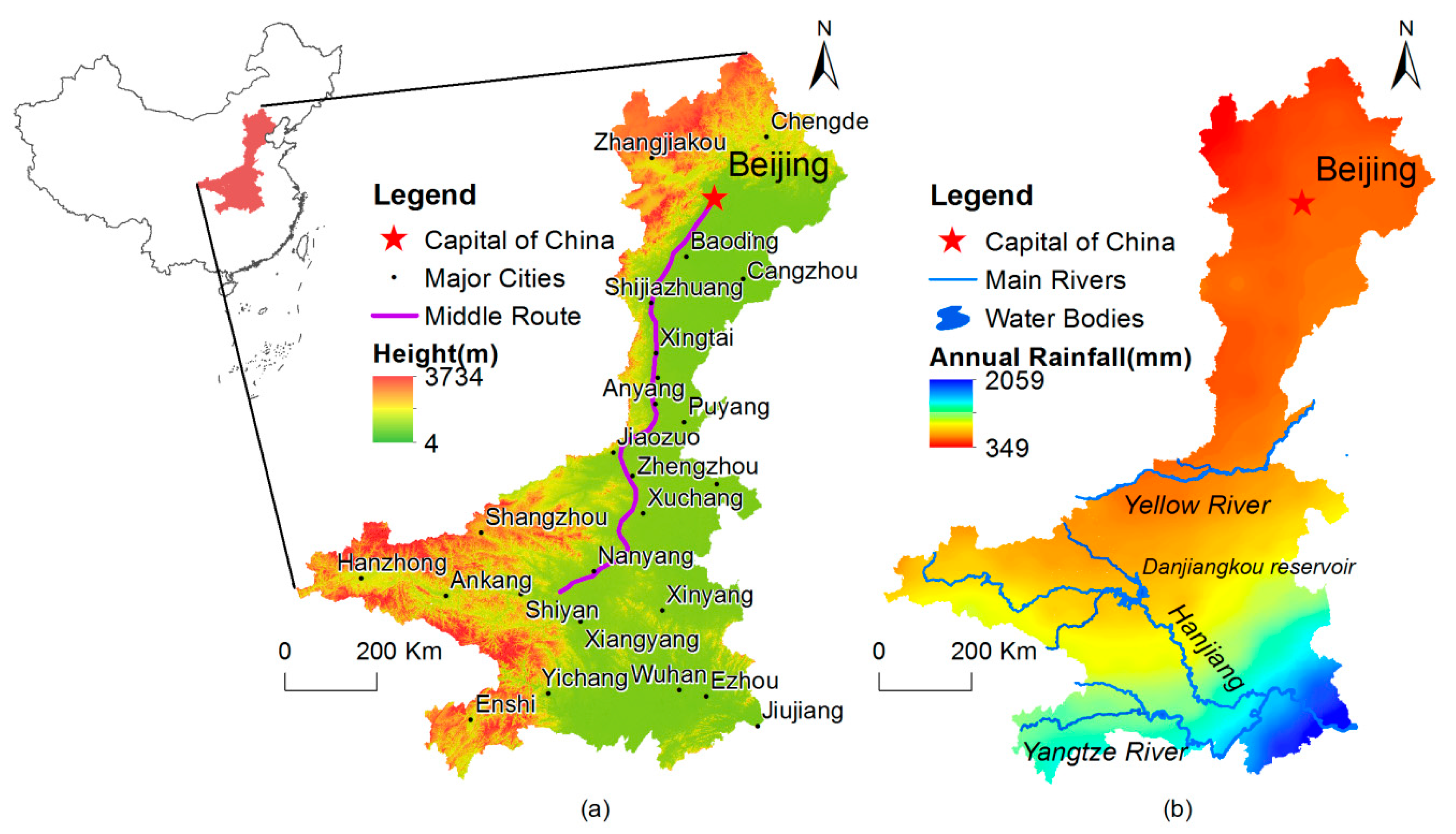
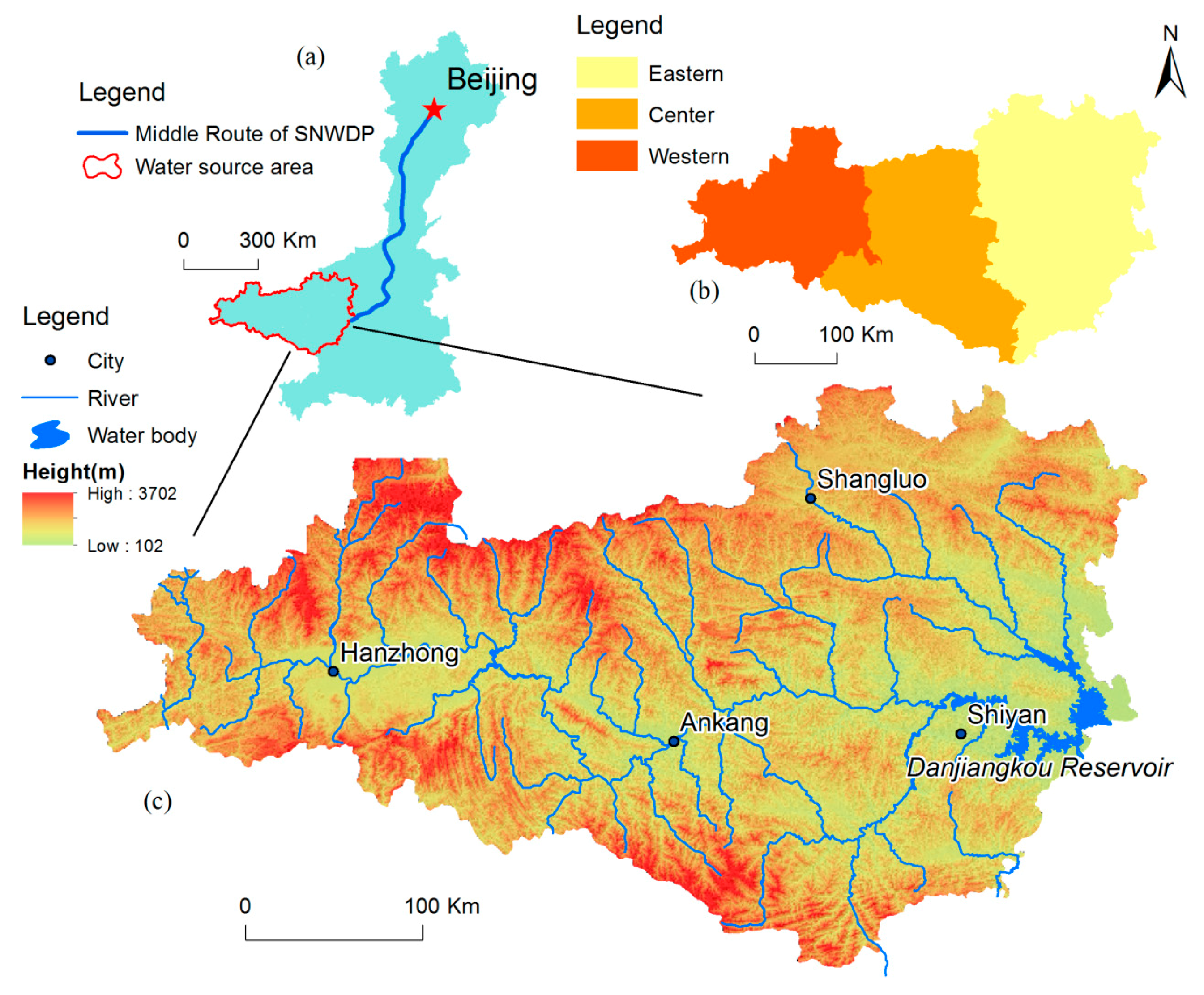
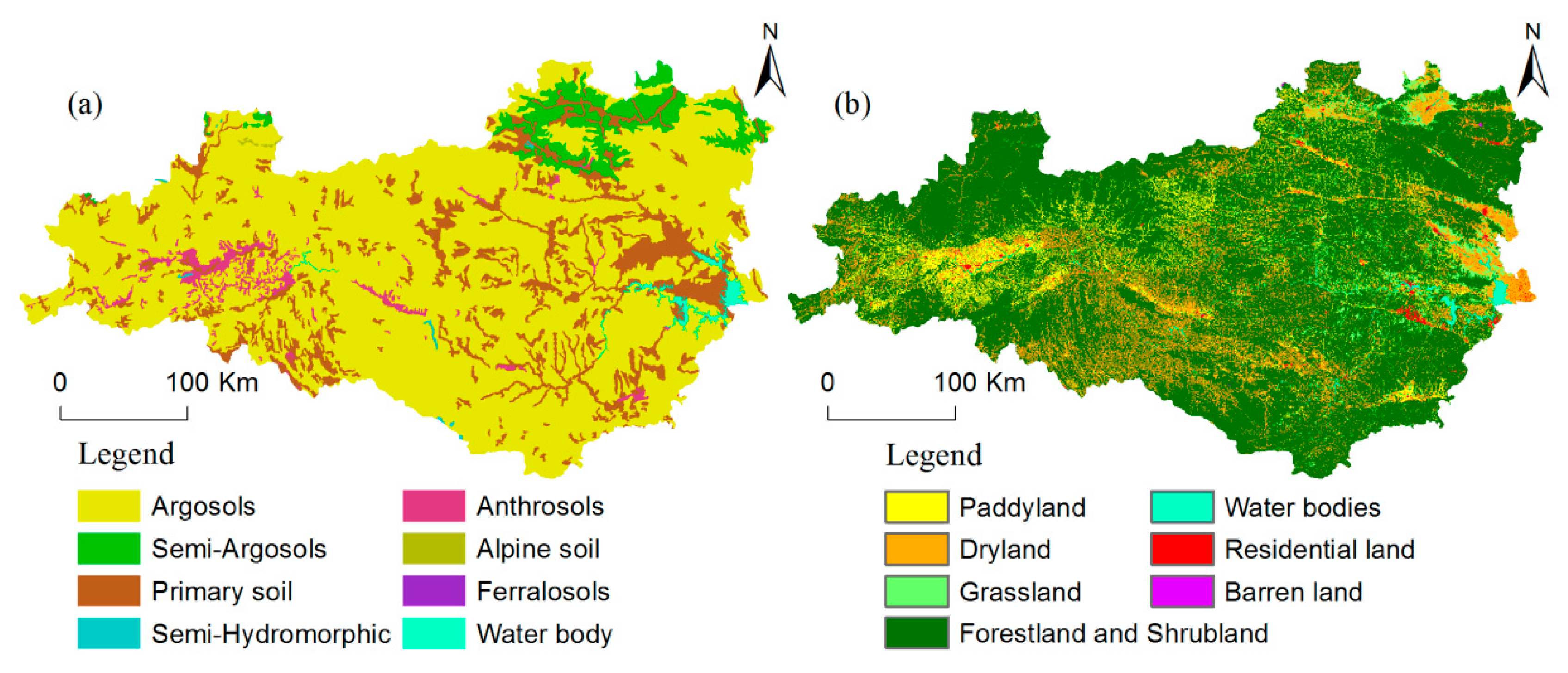

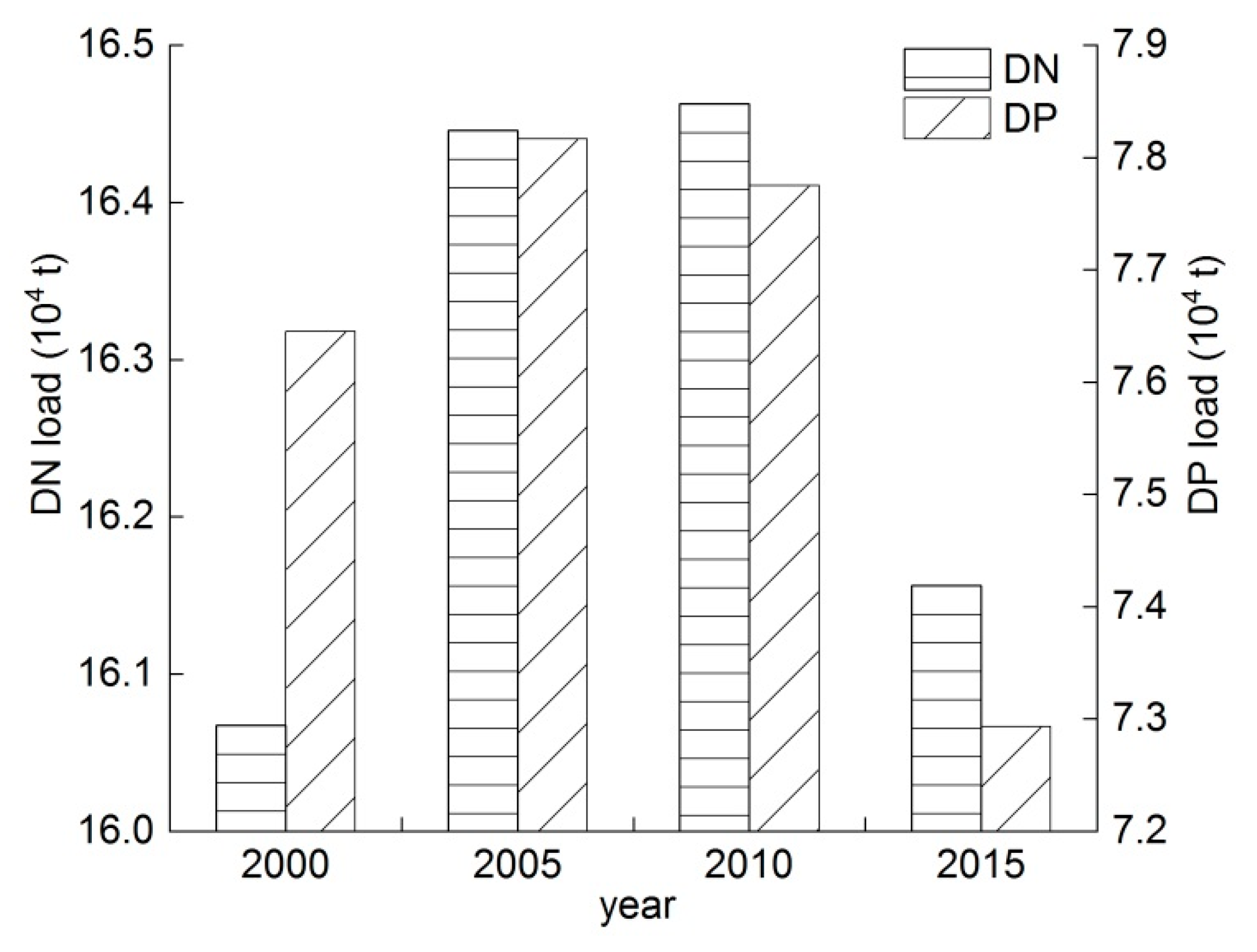

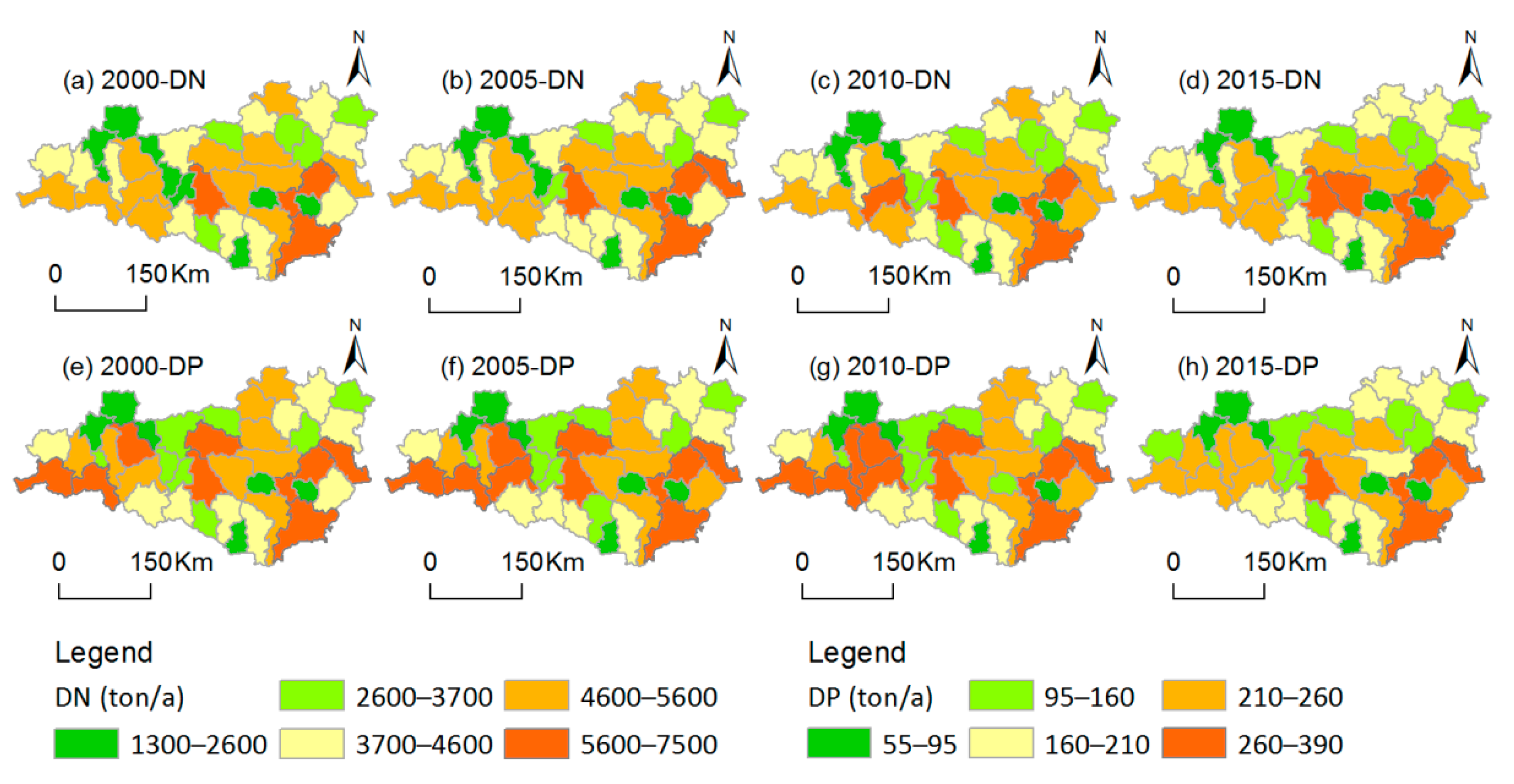
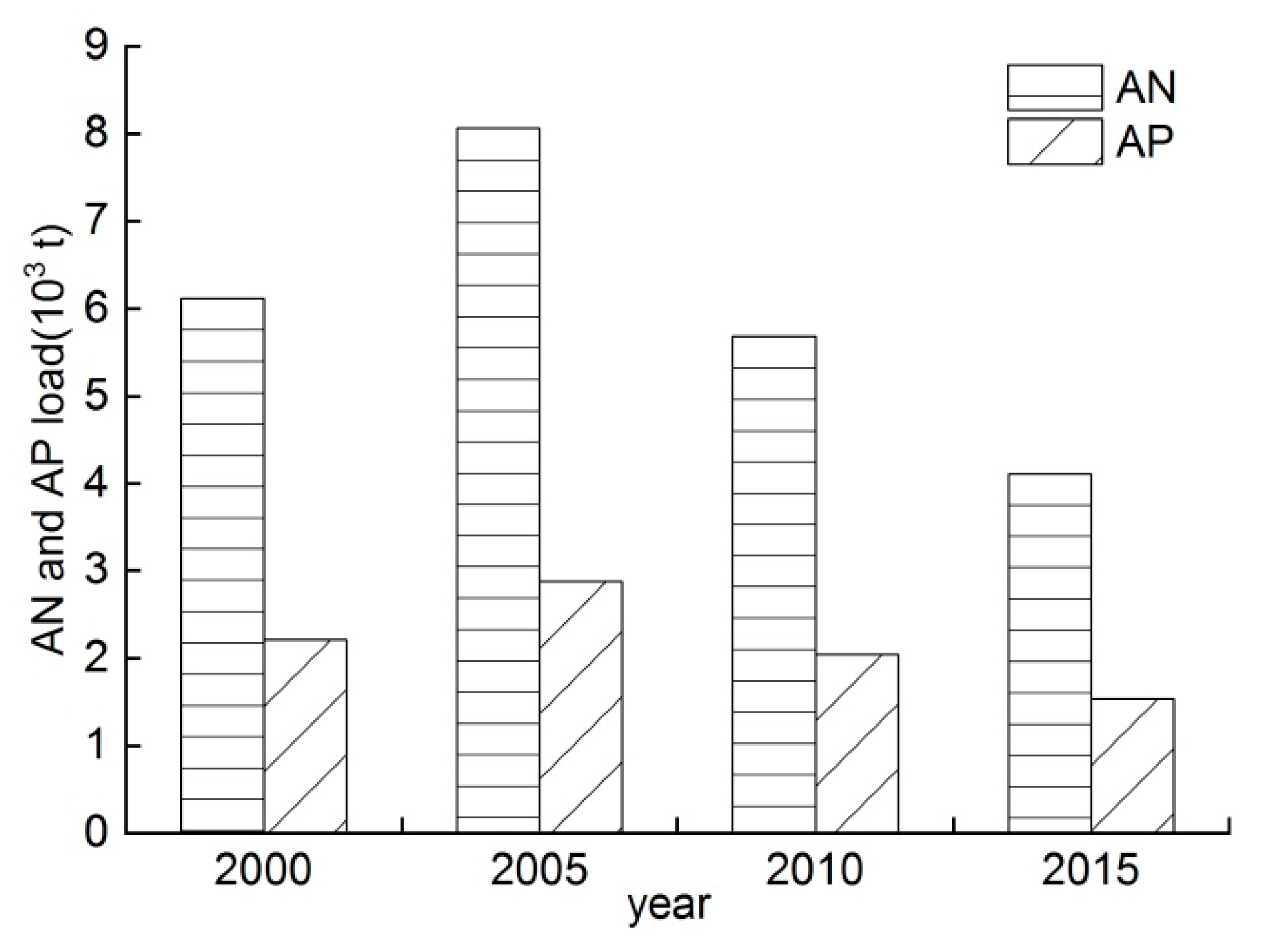
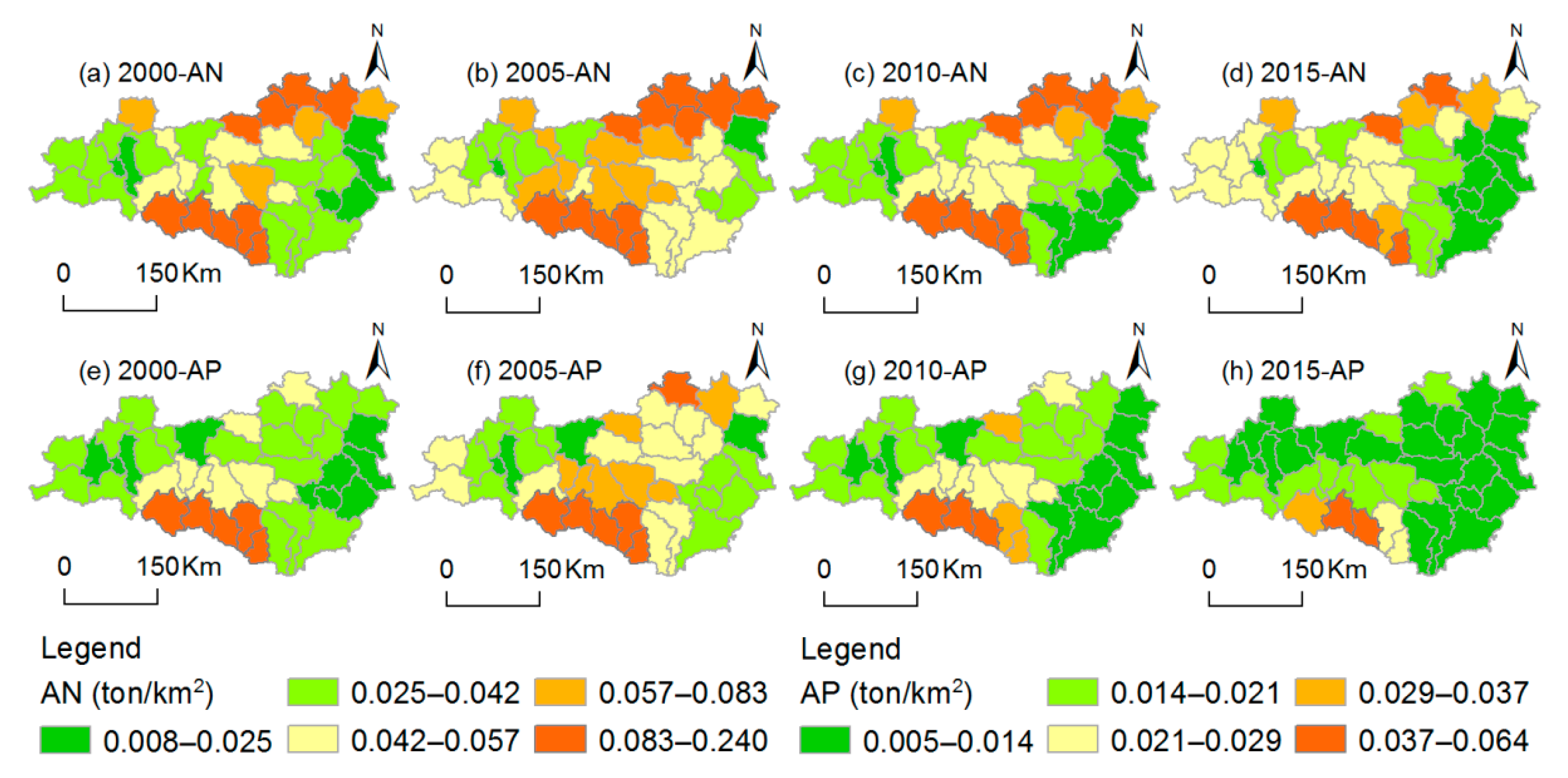
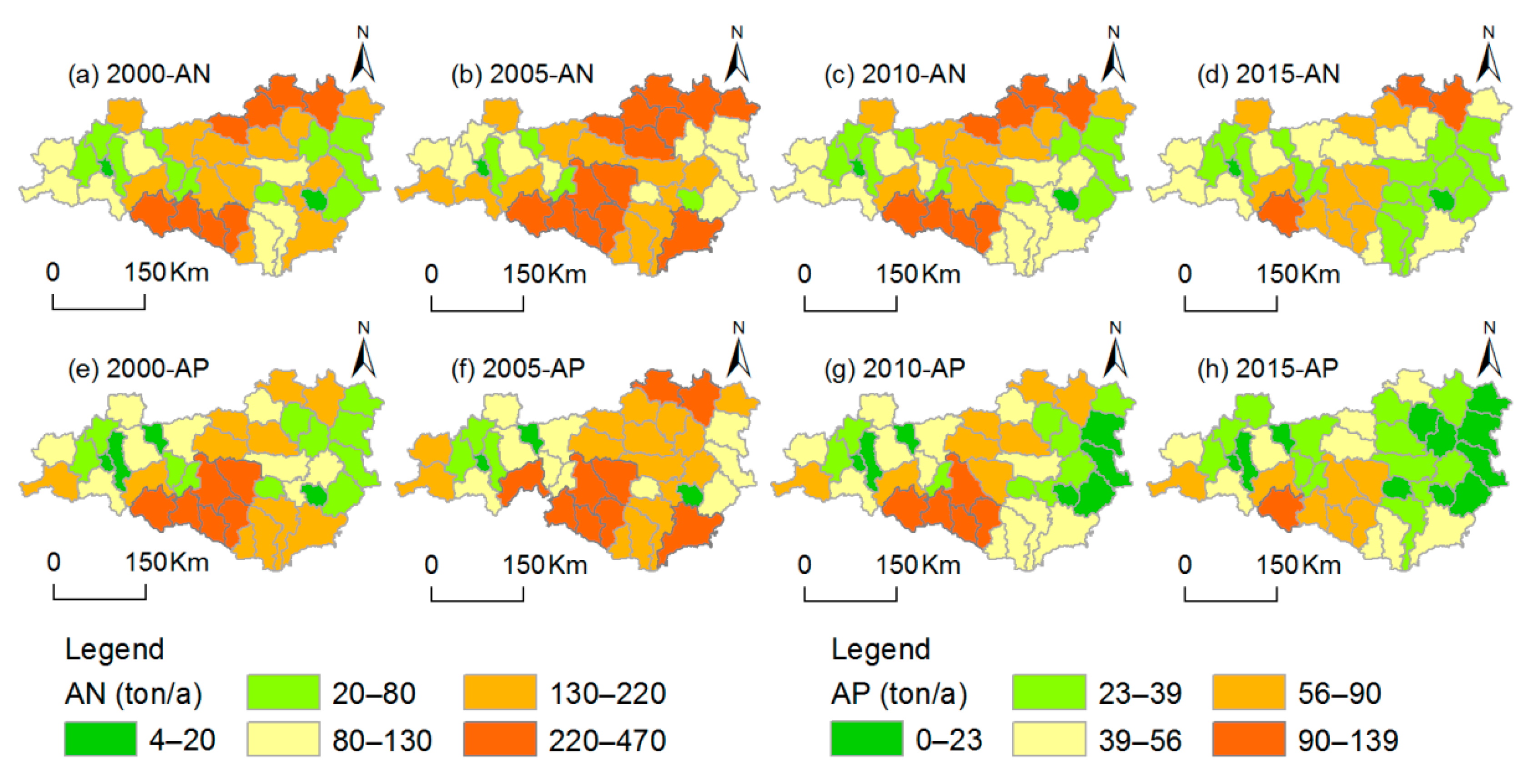



| NPS Pollution Sources | Export Coefficients | |
|---|---|---|
| DN | DP | |
| Paddy field (kg/(km2 × year)) | 2625 | 182 |
| Dry land (kg/(km2 × year)) | 1921 | 79 |
| Forestland (kg/(km2 × year)) | 655 | 18 |
| Shrubland (kg/(km2 × year)) | 1032 | 23 |
| Grassland(kg/(km2 × year)) | 1135 | 38 |
| Residential land(kg/(km2 × year)) | 636 | 36 |
| Barren land(kg/(km2 × year)) | 1121 | 64 |
| Rural population (kg/((ca × 104) × year)) | 19,547 | 2142 |
| Cattle (kg/((ca × 104) × year)) | 113,715 | 2179 |
| Pigs (kg/((ca × 104) × year)) | 26,667 | 1417 |
| Goats (kg/((ca × 104) × year)) | 15,134 | 450 |
| Poultry (kg/((ca × 104) × year)) | 459 | 54 |
| Soil Types | K-Value | Soil Types | K-Value |
|---|---|---|---|
| Yellow-brown soils | 0.225 | Skeletol soils | 0.190 |
| Yellow-cinnamon soils | 0.245 | Lime concretion black soils | 0.262 |
| Brown earths | 0.273 | Mountain meadow soils | 0.254 |
| Dark-brown earths | 0.281 | Fluvo-aquic soils | 0.292 |
| Cinnamon soils | 0.340 | Paddy soils | 0.253 |
| Red clay soils | 0.310 | Dark felty soils | 0.321 |
| Purplish soils | 0.241 | Yellow earths | 0.248 |
| Litho soils | 0.255 | – | – |
| Decoupling Degrees | Relationship between PIOV and Total NPS Pollution Load |
|---|---|
| Strong decoupling (SD) | ∆ENPS ≤ 0, ∆VPIO > 0, DI < 0 |
| Recessive coupling (RC) | ∆ENPS ≥ 0, ∆VPIO < 0, DI ≤ 0 |
| Weak decoupling (WD) | ∆ENPS > 0, ∆VPIO > 0, 0 < DI < 1 |
| Expansive coupling (EC) | ∆ENPS > 0, ∆VPIO > 0, DI ≥ 1 |
| Weak coupling (WC) | ∆ENPS < 0, ∆VPIO < 0, 0 ≤ DI < 1 |
| Recessive coupling (RC) | ∆ENPS < 0, ∆VPIO < 0, DI ≥ 1 |
| Land Use Types | 2000 | 2005 | 2010 | 2015 |
|---|---|---|---|---|
| Barren land (km2) | 10.80 | 10.80 | 11.76 | 24.27 |
| Dry land (km2) | 15,766.81 | 15,497.21 | 15,473.18 | 15,440.34 |
| Grassland (km2) | 4118.02 | 4135.09 | 4103.15 | 4057.47 |
| Paddy field (km2) | 9060.50 | 9004.65 | 8889.55 | 8785.12 |
| Residential land (km2) | 566.37 | 628.93 | 765.85 | 995.24 |
| Shrubland (km2) | 51,529.33 | 51,712.11 | 51,824.92 | 51,729.63 |
| Waterbody (km2) | 976.84 | 1037.55 | 1110.10 | 1189.12 |
| Woodland (km2) | 26,707.76 | 26,710.09 | 26,557.95 | 26,515.25 |
| Year | Growth Rate (%) | DI | Degrees of Decoupling/Coupling | ||||
|---|---|---|---|---|---|---|---|
| PIOV | NPS-N | NPS-P | NPS-N | NPS-P | NPS-N | NPS-P | |
| 2000–2005 | 53.07 | 3.43 | 8.43 | 0.06 | 0.16 | WD | WD |
| 2005–2010 | 112.51 | −1.28 | −8.12 | −0.01 | −0.07 | SD | SD |
| 2010–2015 | 62.78 | −2.72 | −10.15 | −0.04 | −0.16 | SD | SD |
© 2019 by the authors. Licensee MDPI, Basel, Switzerland. This article is an open access article distributed under the terms and conditions of the Creative Commons Attribution (CC BY) license (http://creativecommons.org/licenses/by/4.0/).
Share and Cite
Zhang, L.; Wang, Z.; Chai, J.; Fu, Y.; Wei, C.; Wang, Y. Temporal and Spatial Changes of Non-Point Source N and P and Its Decoupling from Agricultural Development in Water Source Area of Middle Route of the South-to-North Water Diversion Project. Sustainability 2019, 11, 895. https://doi.org/10.3390/su11030895
Zhang L, Wang Z, Chai J, Fu Y, Wei C, Wang Y. Temporal and Spatial Changes of Non-Point Source N and P and Its Decoupling from Agricultural Development in Water Source Area of Middle Route of the South-to-North Water Diversion Project. Sustainability. 2019; 11(3):895. https://doi.org/10.3390/su11030895
Chicago/Turabian StyleZhang, Liguo, Zhanqi Wang, Ji Chai, Yongpeng Fu, Chao Wei, and Ying Wang. 2019. "Temporal and Spatial Changes of Non-Point Source N and P and Its Decoupling from Agricultural Development in Water Source Area of Middle Route of the South-to-North Water Diversion Project" Sustainability 11, no. 3: 895. https://doi.org/10.3390/su11030895
APA StyleZhang, L., Wang, Z., Chai, J., Fu, Y., Wei, C., & Wang, Y. (2019). Temporal and Spatial Changes of Non-Point Source N and P and Its Decoupling from Agricultural Development in Water Source Area of Middle Route of the South-to-North Water Diversion Project. Sustainability, 11(3), 895. https://doi.org/10.3390/su11030895





